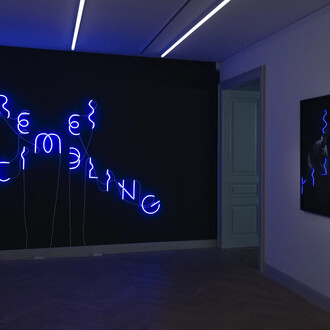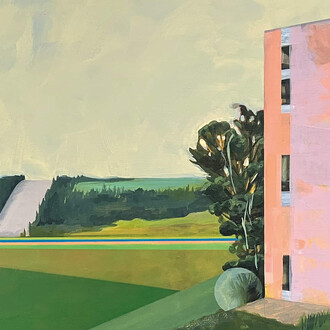I had my stomach pumped as a child because I ate pills thinking they were sweets […] I can’t understand why some people believe completely in medicine and not in art, without questioning either.
(Damien Hirst)
Gagosian is pleased to present “Visual Candy and Natural History,” a selection of paintings and sculptures by Damien Hirst from the early- to mid-1990s. The exhibition coincides with Hirst’s most ambitious and complex project to date, “Treasures from the Wreck of the Unbelievable,” on view at Palazzo Grassi and Punta della Dogana in Venice until December 3.
Since emerging onto the international art scene in the late 1980s as the protagonist of a generation of British artists, Hirst has created installations, sculptures, paintings and drawings that examine the complex relationships between art, beauty, religion, science, life and death. Through series as diverse as the ‘Spot Paintings’, ‘Medicine Cabinets’, ‘Natural History’ and butterfly ‘Kaleidoscope Paintings,’ he has investigated and challenged contemporary belief systems, tracing the uncertainties that lie at the heart of human experience. This exhibition juxtaposes the joyful, colorful abstractions of his ‘Visual Candy’ paintings with the clinical forms of his ‘Natural History’ sculptures.
The ‘Visual Candy’ paintings allude to movements including Impressionism, Abstract Expressionism and Pop Art, while the ‘Natural History’ sculptures—glass tanks containing biological specimens preserved in formaldehyde—reflect the visceral realities of scientific investigation through minimalist design. Despite their stark formal differences, the two series were made during the same period and share conceptual foundations: an exploration of the relationships between pleasure and pain, transience and permanence, logic and emotion.
In the ‘Visual Candy’ paintings, the saturated hues of bubblegum pinks, acid greens and bold blues merge and overlap in loose ovals of thick impasto or repetitive, pointillist-style blots. With euphoric titles such as Happy Happy Happy (1993–94), Wowee Zowee (1993), and Super Silly Fun (1993), the works revel in color and pattern through an informal, nostalgic painting technique, which stands in opposition to the mechanical application of color in Hirst’s spot paintings.
The exuberance of the ‘Visual Candy’ paintings contrasts with the sterility of the ‘Natural History’ sculptures, but the works harmonize when viewed together. The paintings—jubilant and playful, almost decorative—create a sense of comfort against which the full violence of the formaldehyde works can be felt. Damien Hirst was born in 1965 in Bristol, England and lives and works in London and Devon. Collections include 21st Century Museum of Contemporary Art, Kanazawa, Japan; Art Collection Nakano, Japan; Daegu Art Museum, South Korea; National Centre for Contemporary Arts (NCCA), Moscow; The Israel Museum, Jerusalem; Centro de Arte Dos de Mayo (CA2M), Madrid; Museum für Moderne Kunst (MMK), Frankfurt am Main; Museum Brandhorst, Munich; Museo d'Arte Contemporanea Donna Regina (MADRE), Naples; Stedelijk Museum, Amsterdam; Astrup Fearnley Museet for Moderne Kunst, Oslo; Gallery of Modern Art (GoMA), Glasgow; Tate, London; Museo Jumex, Mexico City; The Broad, Los Angeles; Hirshhorn Museum and Sculpture Garden, Washington, D.C.; and Museum of Modern Art, New York. Institutional exhibitions include “The Agony and the Ecstasy,” Museo Archeologico Nazionale di Napoli (2004); “A Selection of Works by Damien Hirst from Various Collections,” Museum of Fine Arts, Boston (2005); “Damien Hirst,” Astrup Fearnley Museet fur Moderne Kunst, Oslo (2005); “For the Love of God,” Rijksmuseum, Amsterdam (2008, traveled to the Palazzo Vecchio, Florence in 2010); “No Love Lost,” The Wallace Collection, London (2009); “Requiem,” PinchukArtCenter, Kiev (2009); “Cornucopia,” Oceanographic Museum of Monaco (2010); “Damien Hirst,” Tate Modern, London (2012); “Relics,” Qatar Museums Authority, Al Riwaq, Qatar (2013); “Signification (Hope, Immortality and Death in Paris, Now and Then),” Deyrolle, Paris (2014); “Damien Hirst,” Astrup Fearnley Museum of Modern Art, Oslo (2015); “Damien Hirst: New Religion,” The Museum of Contemporary Art of Republika of Srpska, Banja Luka, Bosnia & Herzegovina (2016, traveled to Museum of Contemporary Art Vojvodina, Novi Sad, Serbia); “Damien Hirst: The Last Supper,” National Gallery of Art, Washington, DC (2016); and “Treasures from the Wreck of the Unbelievable,” Palazzo Grassi and Punta della Dogana, François Pinault Foundation, Venice (2017). Hirst received the Turner Prize in 1995.
“Visual Candy and Natural History” takes its title from Hirst’s 1993 exhibition at Regen Projects in Los Angeles.
















![Karel Appel, Le coq furieux [The furious rooster] (detail), 1952. Courtesy of Kunstmuseum Bern](http://media.meer.com/attachments/de322f88933729d2014dc4e021d4a6694046a744/store/fill/330/330/c26a6c5ef5e2ed397d4a2e9bc00ac739c40ba8384f45f9ce1ed85adba600/Karel-Appel-Le-coq-furieux-The-furious-rooster-detail-1952-Courtesy-of-Kunstmuseum-Bern.jpg)